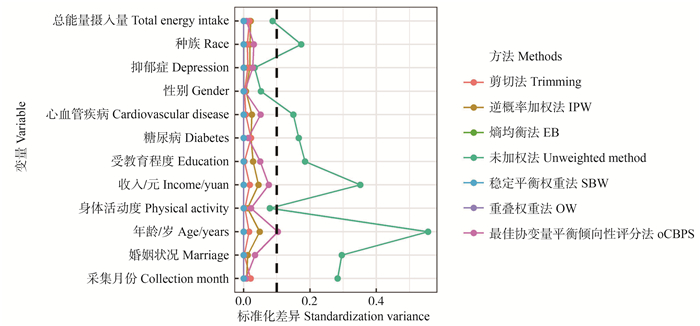A simulation comparison and application study of extreme weighting methods in propensity score inverse probability weighting
-
摘要:
目的 通过模拟研究比较倾向性评分逆概率加权法(inverse probability weighting, IPW)及其5种替代方法在有限重叠和倾向评分模型错误指定下的性能,并应用这些方法探讨血清总25-羟基维生素D[25-hydroxyvitamin D, 25(OH)D]缺乏与成年人睡眠时间的关系。 方法 通过蒙特卡洛模拟,设置不同样本量、倾向性评分重叠度、模型指定情况的模拟场景,比较6种方法的统计性能。 结果 模拟结果显示,IPW对重叠度差和模型错误指定比较敏感,其替代方法可表现出更强的稳定性和更高的效率,其中重叠权重(overlap weights, OW)法可提供最好的效应估计。血清总25(OH)D缺乏者睡眠时间比血清总25(OH)D充足者少(P < 0.001)。 结论 OW可作为存在极端权重时IPW方法的最优替代,血清总25(OH)D缺乏会减少成年人的睡眠时间。 Abstract:Objective This paper proposes a simulation study to compare the performance of propensity score inverse probability weighting (IPW) and its five alternatives under limited overlap and propensity score model misspecification. Additionally, it seeks to employ these methods to explore the relationship between serum total 25-hydroxyvitamin D [25(OH)D] deficiency and sleep duration in adults. Methods The statistical performance of these six methods was compared through Monte Carlo simulations by setting up simulation scenarios with different sample sizes, propensity score overlap, and model-specified cases. Results Simulation results showed that IPW is particularly sensitive to differences in overlap and model misspecification, while alternative methods showed greater stability and higher efficiency. Notably, the overlap weights (OW) method provided the most accurate effect estimates. It was observed that adults with total serum 25(OH)D deficiency have shorter sleep duration compared to those with adequate total serum 25(OH)D (P < 0.001). Conclusions The OW method can be used as an optimal alternative to the IPW method in the presence of extreme weights. The study also concludes that serum total 25(OH)D deficiency reduces sleep duration in adults. -
图 1 加权前及加权后2组个体各基线协变量均衡性情况
IPW, 逆概率加权法;EB, 熵均衡法;SBW, 稳定权重值均衡法;OW, 重叠权重法;oCBPS, 最优协变量均衡法。
Figure 1. Balance of baseline covariates of individuals in the two groups before and after weighting
IPW, inverse probability weight; EB, entropy balancing; SBW, stable weights that balance covariates; OW, overlap weights; oCBPS, optimal covariate balancing.
表 1 IPW及替代方法在不同重叠度下的模拟表现
Table 1. Simulation performance of IPW and alternative methods under different overlap degrees
重叠度
Degree of overlap方法
Method偏倚
Bias均方根误差
RMSEs $ s_{\bar{x}}$ 95% CI覆盖率
Coverage probability好Good IPW 0.17 9.06 9.06 8.55 0.95 剪切法Trimming 0.06 7.72 7.73 7.66 0.95 OW 0.14 6.90 6.90 6.66 0.93 oCBPS -0.02 7.34 7.34 6.95 0.93 EB 0.12 7.00 7.00 19.20 1.00 SBW 0.16 6.95 6.95 18.26 1.00 中Middle IPW 1.08 25.09 25.08 17.90 0.89 剪切法Trimming 0.24 9.44 9.44 9.37 0.95 OW 0.21 7.52 7.52 7.36 0.94 oCBPS 0.36 9.49 9.49 15.15 0.98 EB 0.19 8.17 8.17 22.90 1.00 SBW 0.33 7.88 7.87 19.48 1.00 差Poor IPW 7.68 42.25 41.57 27.94 0.76 剪切法Trimming 0.40 10.13 10.13 10.26 0.96 OW 0.32 8.05 8.05 8.15 0.95 oCBPS 1.55 13.01 15.40 76.23 1.00 EB 0.45 9.36 12.92 26.79 1.00 SBW 0.55 8.66 9.35 20.84 1.00 注: IPW, 逆概率加权法; OW, 重叠权重法; oCBPS, 最优协变量均衡法; EB, 熵均衡法; SBW, 稳定权重值均衡法; RMSE, 均方根误差。
Note : IPW, inverse probability weight; OW, overlap weights; oCBPS, optimal covariate balancing; EB, entropy balancing; SBW, stable weights that balance covariates; RMSE, root mean square error.表 2 IPW及替代方法在模型正确指定和错误指定下的模拟表现
Table 2. Simulation performance of IPW and alternative methods under correct and incorrect model settings
模型设定
Model settings方法
Method偏倚
Bias均方根误差
RMSEs $ s_{\bar{x}}$ 95% CI覆盖率
Coverage probability正确Correct IPW 1.08 25.09 25.08 17.90 0.89 剪切法Trimming 0.24 9.44 9.44 9.37 0.95 OW 0.21 7.52 7.52 7.36 0.94 oCBPS 0.36 9.49 9.49 15.15 0.98 EB 0.19 8.17 8.17 22.90 1.00 SBW 0.33 7.88 7.87 19.48 1.00 错误Incorrect IPW 2.74 25.88 25.75 20.53 0.86 剪切法Trimming 0.43 9.22 9.22 9.36 0.95 OW 0.41 7.33 7.33 7.51 0.96 oCBPS 1.23 9.63 9.55 9.88 0.95 EB 0.22 7.76 7.76 23.25 1.00 SBW 0.35 7.55 7.55 18.34 1.00 注: IPW, 逆概率加权法; OW, 重叠权重法; oCBPS, 最优协变量均衡法; EB, 熵均衡法; SBW, 稳定权重值均衡法; RMSE: 均方根误差。
Note : IPW, inverse probability weight; OW, overlap weights; oCBPS, optimal covariate balancing; EB, entropy balancing; SBW, stable weights that balance covariates; RMSE, root mean square error.表 3 IPW及替代方法的效应估计
Table 3. Effect estimates of IPW and alternative methods
方法Method 平均处理效应ATE $s_{\bar{x}} $ 95% CI P值value 未加权 0.117 6 0.049 8 0.019 9~0.215 2 0.018 IPW 0.200 0 0.054 6 0.093 1~0.307 0 < 0.001 剪切法Trimming 0.187 4 0.055 7 0.078 3~0.296 6 < 0.001 OW 0.208 6 0.054 0 0.102 7~0.314 4 < 0.001 oCBPS 0.700 9 0.056 9 0.589 4~0.812 4 0.003 EB 0.206 6 0.055 2 0.098 4~0.314 8 < 0.001 SBW 0.225 2 0.055 7 0.116 0~0.334 4 < 0.001 注: IPW, 逆概率加权法;OW, 重叠权重法;oCBPS, 最优协变量均衡法;EB, 熵均衡法;SBW, 稳定权重值均衡法。
Note : IPW, inverse probability weight; OW, overlap weights; oCBPS, optimal covariate balancing; EB, entropy balancing; SBW, stable weights that balance covariates. -
[1] Rosenbaum PR. Observational studies (2nd ed.)[Z]. New York: Springer, 2002. [2] Rosenbaum PR, Rubin DB. The central role of the propensity score in observational studies for causal effects[J]. Biometrika, 1983, 70(1): 41-55. DOI: 10.1093/biomet/70.1.41. [3] Robins JM, Rotnitzky A, Zhao LP. Estimation of regression coefficients when some regressors are not always observed[J]. J Am Stat Assoc, 1994, 89(427): 846-866. DOI: 10.1080/01621459.1994.10476818. [4] Hirano K, Imbens GW, Ridder G. Efficient estimation of average treatment effects using the estimated propensity score[J]. Econometrica, 2003, 71(4): 1161-1189. DOI: 10.1111/1468-0262.00442. [5] Horvitz DG, Thompson DJ. A generalization of sampling without replacement from a finite universe[J]. J AM Stat Assoc, 1952, 47(260): 663-685. DOI: 10.1080/01621459.1952.10483446. [6] Chesnaye NC, Stel VS, Tripepi G, et al. An introduction to inverse probability of treatment weighting in observational research[J]. Clin Kidney J, 2022, 15(1): 14-20. DOI: 10.1093/ckj/sfab158. [7] Ju C, Schwab J, van der Laan MJ. On adaptive propensity score truncation in causal inference[J]. Stat Methods Med Res, 2019, 28(6): 1741-1760. DOI: 10.1177/0962280218774817. [8] McCaffrey DF, Ridgeway G, Morral AR. Propensity score estimation with boosted regression for evaluating causal effects in observational studies[J]. Psychol Methods, 2004, 9(4): 403-425. DOI: 10.1037/1082-989X.9.4.403. [9] Hainmueller J. Entropy balancing for causal effects: A multivariate reweighting method to produce balanced samples in observational studies[J]. Political Analysis, 2011, 20(1): 25-46. DOI: 10.1093/pan/mpr025. [10] Zubizarreta JR. Stable weights that balance covariates for estimation with incomplete outcome data[J]. J Am Stat Assoc, 2015, 110(511): 910-922. DOI: 10.1080/01621459.2015.1023805. [11] Li F, Morgan KL, Zaslavsky AM. Balancing covariates via propensity score weighting[J]. J AM Stat Assoc, 2018, 113(521): 390-400. DOI: 10.1080/01621459.2016.1260466. [12] Fan JQ, Imai K, Lee I, et al. Optimal covariate balancing conditions in propensity score estimation[J]. J Bus Econ Stat, 2023, 41(1): 97-110. DOI: 10.1080/07350015.2021.2002159. [13] Crump RK, Hotz VJ, Imbens GW, et al. Dealing with limited overlap in estimation of average treatment effects[J]. Biometrika, 2009, 96(1): 187-199. DOI: 10.1093/biomet/asn055. [14] Li L, Greene T. A weighting analogue to pair matching in propensity score analysis[J]. Int J Biostat, 2013, 9(2): 215-234. DOI: 10.1515/ijb-2012-0030. [15] Bin YS, Marshall NS, Glozier N. Secular trends in adult sleep duration: a systematic review[J]. Sleep Med Rev, 2012, 16(3): 223-230. DOI: 10.1016/j.smrv.2011.07.003. [16] Piovezan RD, Hirotsu C, Feres MC, et al. Obstructive sleep apnea and objective short sleep duration are independently associated with the risk of serum vitamin D deficiency[J]. PLoS One, 2017, 12(7): e0180901. DOI: 10.1371/journal.pone.0180901. [17] Bertisch SM, Sillau S, De Boer IH, et al. 25-hydroxyvitamin D concentration and sleep duration and continuity: multi-ethnic study of atherosclerosis[J]. Sleep, 2015, 38(8): 1305-1311. DOI: 10.5665/sleep.4914. [18] Shiue I. Low vitamin D levels in adults with longer time to fall asleep: US NHANES, 2005-2006[J]. Int J Cardiol, 2013, 168(5): 5074-5075. DOI: 10.1016/j.ijcard.2013.07.195. [19] Thomas LE, Li F, Pencina MJ. Overlap weighting: a propensity score method that mimics attributes of a randomized clinical trial[J]. JAMA, 2020, 323(23): 2417-2418. DOI: 10.1001/jama.2020.7819. [20] Zhou YJ, Matsouaka RA, Thomas L. Propensity score weighting under limited overlap and model misspecification[J]. Stat Methods Med Res, 2020, 29(12): 3721-3756. DOI: 10.1177/0962280220940334. [21] Pereira-Santos M, Costa PR, Assis AM, et al. Obesity and vitamin D deficiency: a systematic review and meta-analysis[J]. Obes Rev, 2015, 16(4): 341-349. DOI: 10.1111/obr.12239. -





 下载:
下载:

